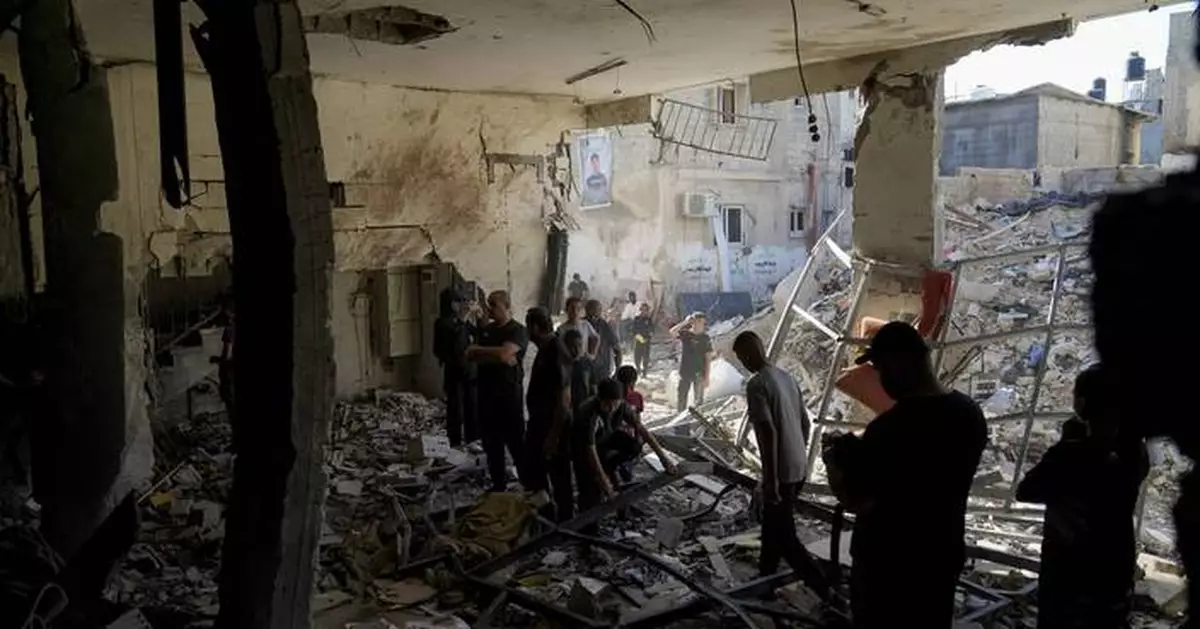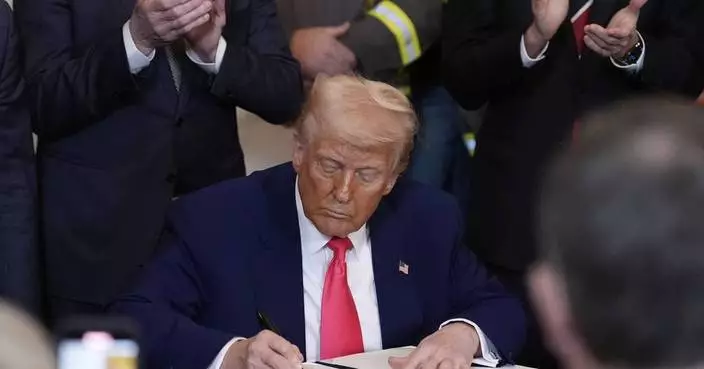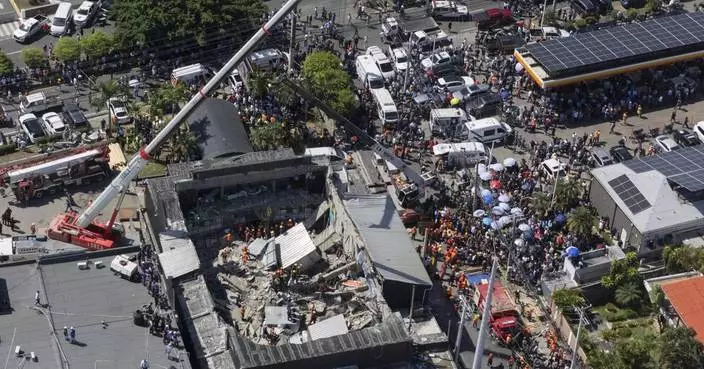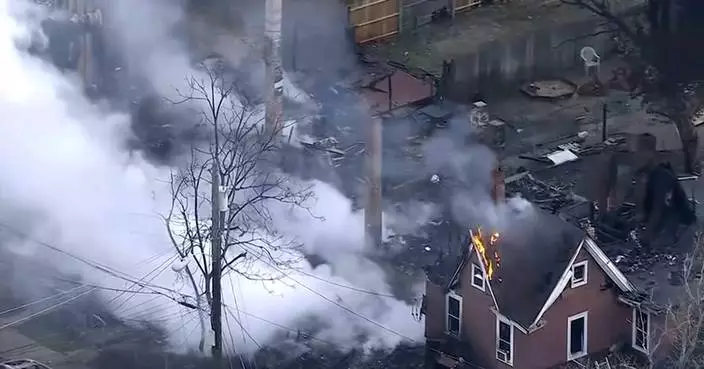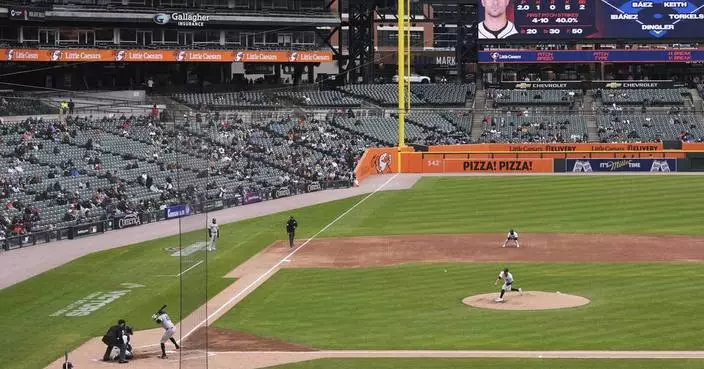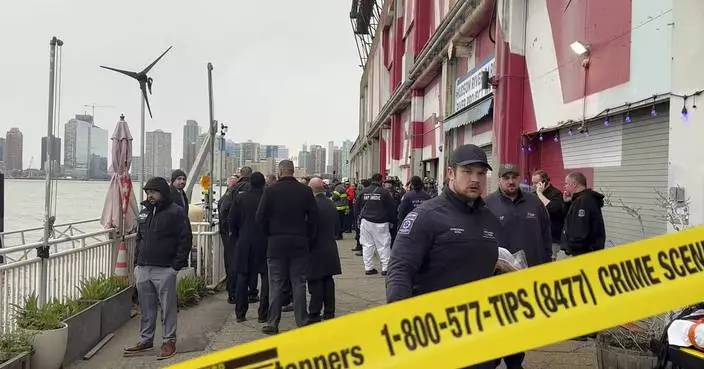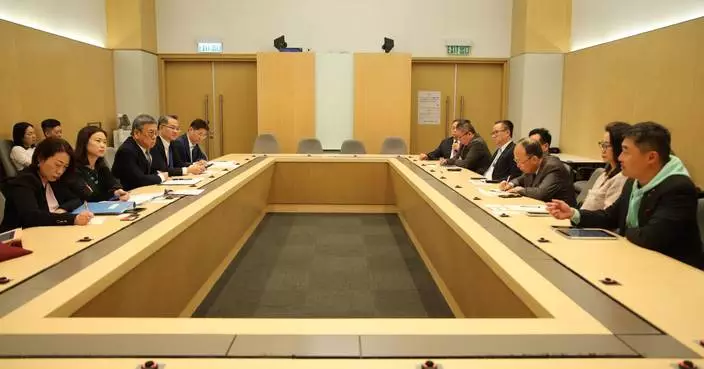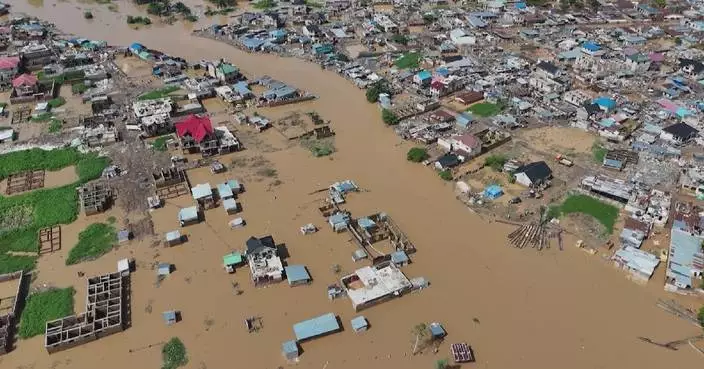TULKAREM, West Bank (AP) — An Israeli airstrike on a West Bank cafe that the military said targeted Palestinian militants also killed a family of four, including two young children, relatives told The Associated Press on Friday.
The strike slammed into a three-story building in the Tulkarem refugee camp late Thursday, setting it on fire, destroying a popular cafe and killing at least 18 Palestinians, according to the territory's Health Ministry. It was the deadliest strike in the West Bank since the start of the Israel-Hamas war nearly a year ago.
Click to Gallery
Palestinians examine the damage following an Israeli airstrike in the West Bank city of Tulkarem, which Palestinian health officials say killed 18 people and the Israeli military says took out a Hamas leader, on Friday, Oct. 4, 2024. (AP Photo/Nasser Nasser)
Palestinians examine the damage following an Israeli airstrike in the West Bank city of Tulkarem, which Palestinian health officials say killed 18 people and the Israeli military says took out a Hamas leader, on Friday, Oct. 4, 2024. (AP Photo/Nasser Nasser)
Palestinians examine the damage following an Israeli airstrike in the West Bank city of Tulkarem, which Palestinian health officials say killed 18 people and the Israeli military says took out a Hamas leader, on Friday, Oct. 4, 2024. (AP Photo/Nasser Nasser)
Palestinians examine the damage following an Israeli airstrike in the West Bank city of Tulkarem, which Palestinian health officials say killed 18 people and the Israeli military says took out a Hamas leader, on Friday, Oct. 4, 2024. (AP Photo/Nasser Nasser)
Palestinians examine the damage following an Israeli airstrike in the West Bank city of Tulkarem, which Palestinian health officials say killed 18 people and the Israeli military says took out a Hamas leader, on Friday, Oct. 4, 2024. (AP Photo/Nasser Nasser)
Palestinians examine the damage following an Israeli airstrike in the West Bank city of Tulkarem, which Palestinian health officials say killed 18 people and the Israeli military says took out a Hamas leader, on Friday, Oct. 4, 2024. (AP Photo/Nasser Nasser)
On Friday, paramedics searched the rubble inside the blasted-out coffee shop, gathering human remains into small boxes. Young boys and men walked among the ruins of the shop, with holes in the ceiling and debris blanketing the ground, digging past bloodstained furniture and dislodged iron beams for anything to salvage.
Among the dead was the Abu Zahra family: Muhammad, a bakery worker; his wife, Saja; and their two children, Sham, 8, and Karam, 6, according to the man's brother, Mustafa Abu Zahra, who said the family lived above the coffee shop. He added that one of Muhammad’s brothers-in-law was also in the apartment at the time and was killed.
The Israeli military said the strike killed at least nine militants who were gathering to plan an attack against Israel, including Hamas’ leader in the camp, whom it accused without providing evidence of taking part in multiple attacks against Israeli civilians. It also said a “key operative” of Islamic Jihad, another Palestinian militant group, was killed in the strike. Tulkarem, known to be a hotbed of Palestinian militancy, is a frequent target of Israeli military raids.
Hundreds of mourners packed the streets of the camp Friday during a mass funeral for the 18 killed, some brandishing Hamas flags. Hamas did not immediately claim any of the dead as its fighters but released a statement condemning the strike and calling for Palestinians in Tulkarem to rise up.
U.N. Secretary-General Antonio Guterres strongly condemned the loss of lives in the Israeli airstrike on the Tulkaram camp and called for strict compliance with international law requiring the protection of civilians and civilian infrastructure, U.N. spokesman Stephane Dujarric said.
Israel has carried out several large-scale raids in the West Bank since the start of the war in Gaza, ignited by Hamas' Oct. 7 attack on southern Israel. While airstrikes used to be rare in the Palestinian territory, they have grown more common since the outbreak of war as Israeli forces clamp down, saying they aim to prevent attacks on their citizens.
Israeli fire has killed at least 722 Palestinians in the West Bank since Oct. 7, Palestinian health officials say. In that time, Palestinian militants have launched a number of attacks on soldiers at checkpoints and within Israel.
A shooting attack in Tel Aviv earlier this week that Israeli police said was carried out by Palestinians from the West Bank left at least six people dead.
Nimer Fayat, the owner of Dr. Coffee, said the cafe was full of “regular customers coming to eat and drink” when the strike occurred around 10:15 p.m.
“What happened was a very strong blow, the likes of which we had not seen in the past since the Al-Aqsa Intifada,” he said, using a Palestinian term for the second intifada, or uprising, in the early 2000s.
Paramedics rushing to the area encountered a ghastly scene, with body parts flung onto power lines by the force of the blast, said Nebal Farsakh, a spokesperson for the Palestinian Red Crescent, whose teams brought nine dead to the hospital.
A full list of the dead and wounded was not immediately released by the Palestinian Health Ministry.
Yasser Jibra, another relative of the Abu Zahras, said the strike was “like a lightning bolt.”
“Look around, the destruction is so obvious," he said, adding that it was difficult to identify the bodies of his loved ones.
The Israeli military did not immediately respond to a request for comment on civilian deaths in the strike. Israel says it takes care to guard against such deaths.
But to Jibra, that means little.
“This is the work of the criminal occupation, which does not take into account the presence of a child or a woman, or an elderly or young person," he said, as he stood inside the blasted-out cafe. "Everything is permissible for them.”
Associated Press reporter Julia Frankel and producer Ibrahim Hazboun contributed to this report from Jerusalem.
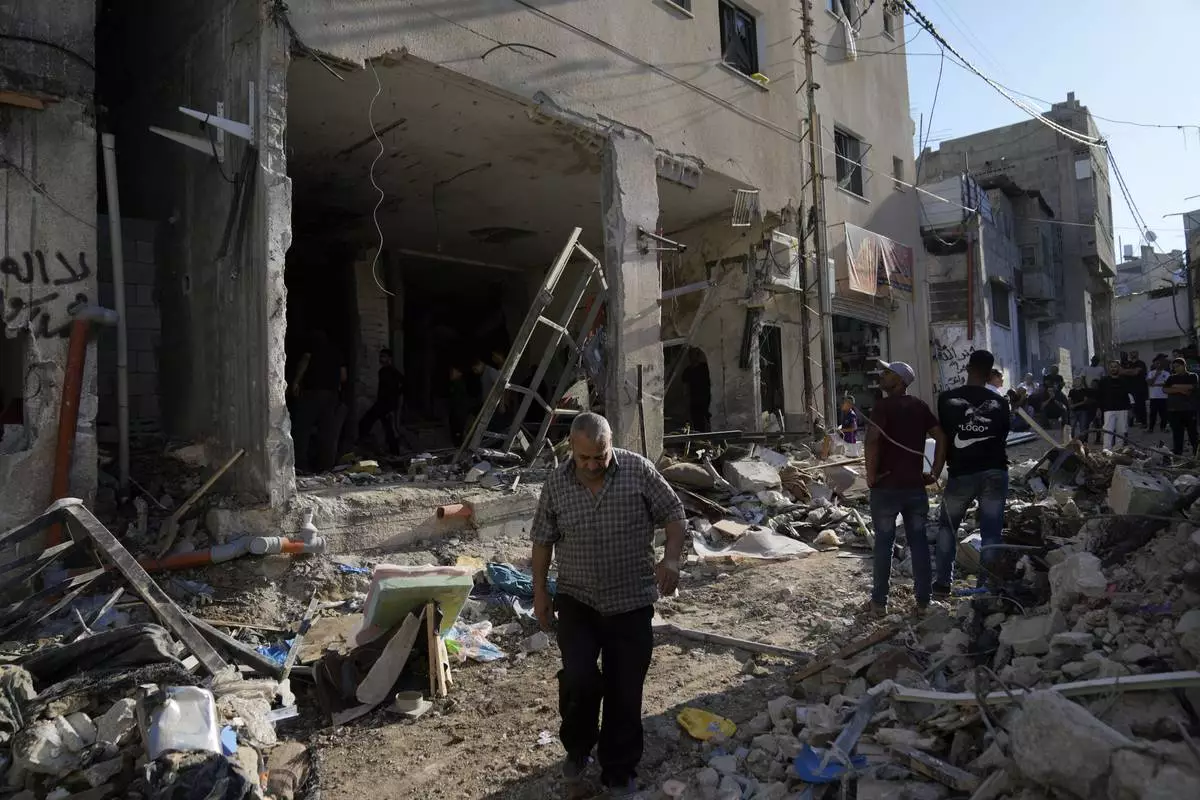
Palestinians examine the damage following an Israeli airstrike in the West Bank city of Tulkarem, which Palestinian health officials say killed 18 people and the Israeli military says took out a Hamas leader, on Friday, Oct. 4, 2024. (AP Photo/Nasser Nasser)
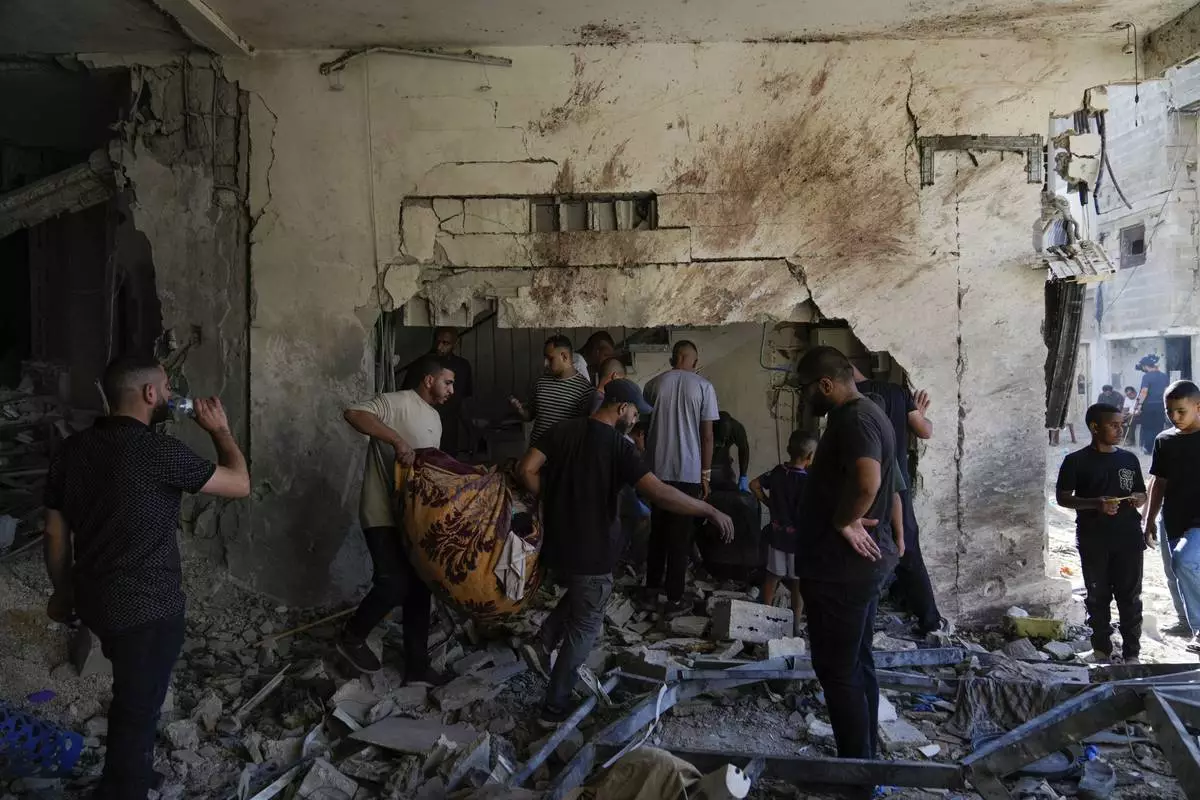
Palestinians examine the damage following an Israeli airstrike in the West Bank city of Tulkarem, which Palestinian health officials say killed 18 people and the Israeli military says took out a Hamas leader, on Friday, Oct. 4, 2024. (AP Photo/Nasser Nasser)
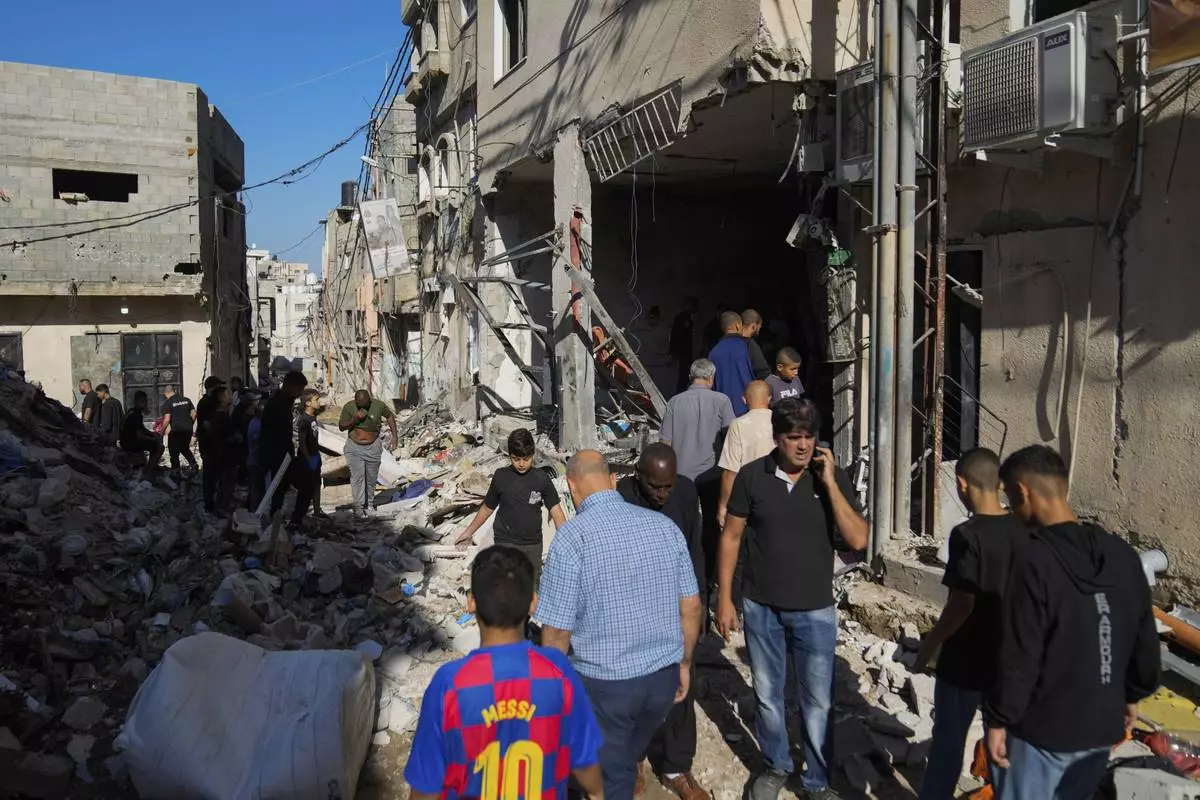
Palestinians examine the damage following an Israeli airstrike in the West Bank city of Tulkarem, which Palestinian health officials say killed 18 people and the Israeli military says took out a Hamas leader, on Friday, Oct. 4, 2024. (AP Photo/Nasser Nasser)
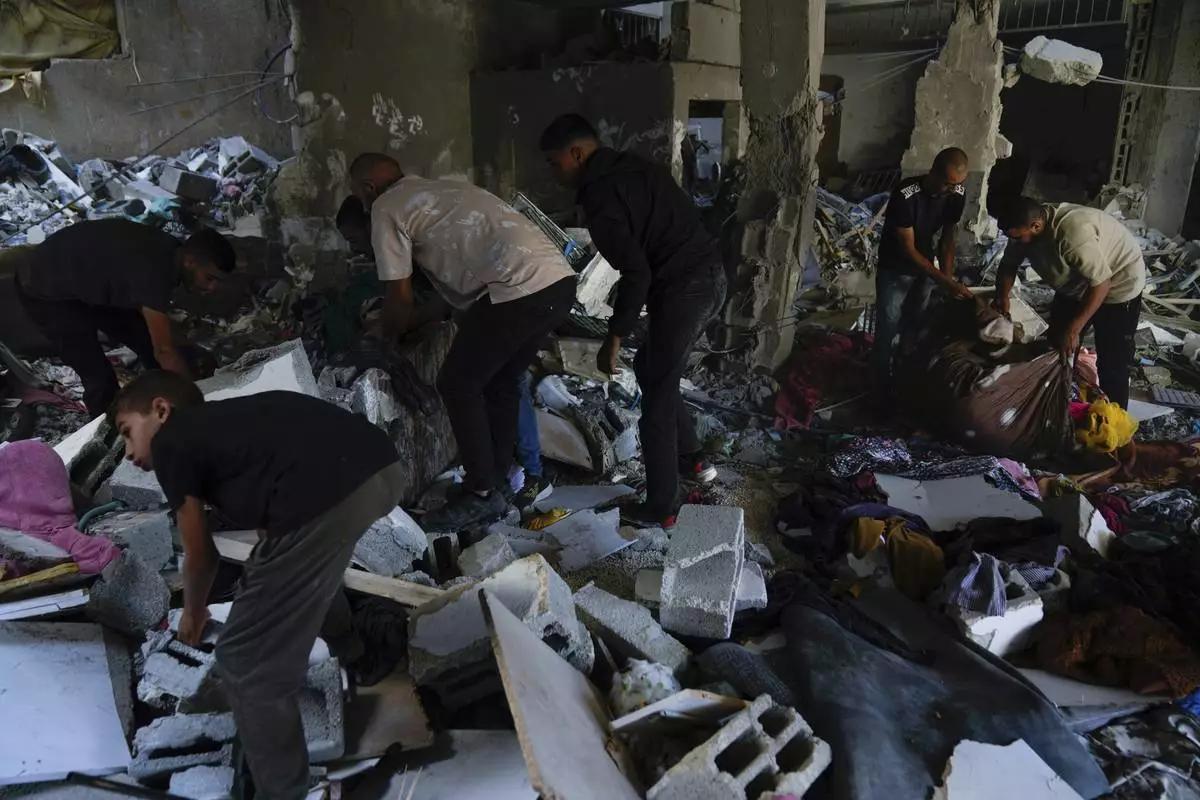
Palestinians examine the damage following an Israeli airstrike in the West Bank city of Tulkarem, which Palestinian health officials say killed 18 people and the Israeli military says took out a Hamas leader, on Friday, Oct. 4, 2024. (AP Photo/Nasser Nasser)
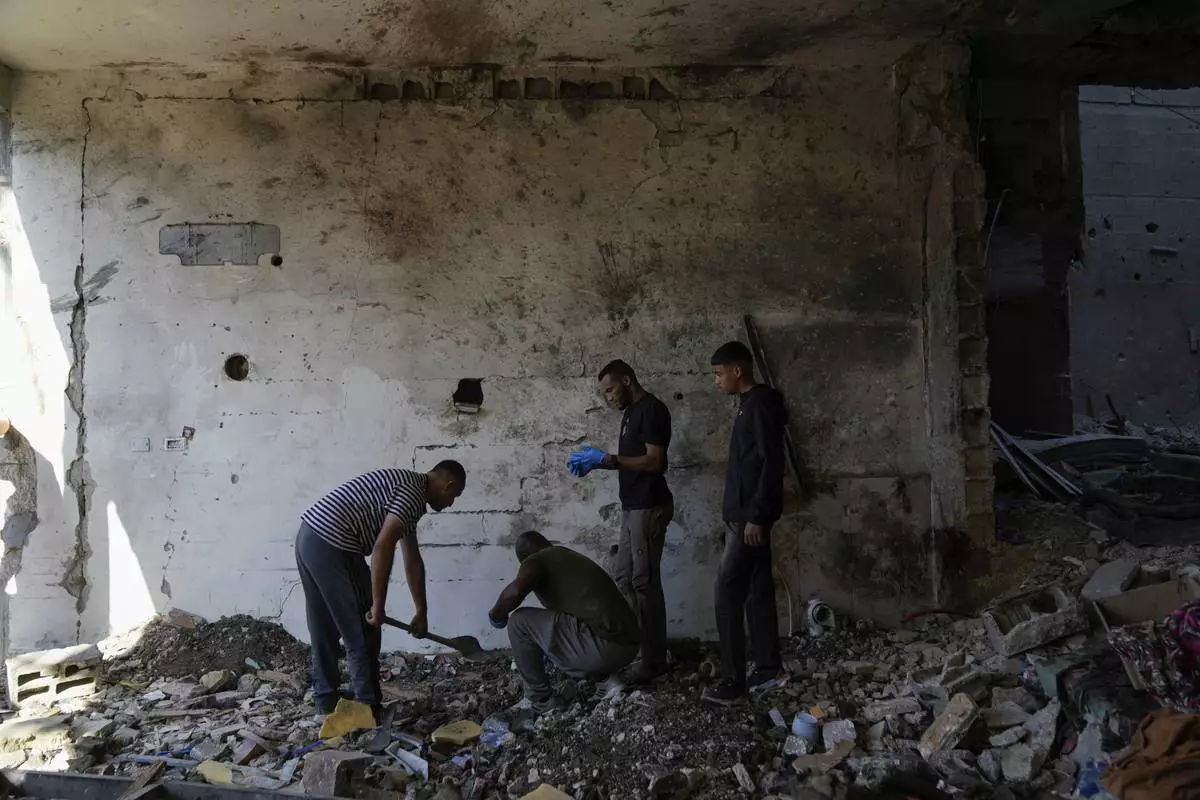
Palestinians examine the damage following an Israeli airstrike in the West Bank city of Tulkarem, which Palestinian health officials say killed 18 people and the Israeli military says took out a Hamas leader, on Friday, Oct. 4, 2024. (AP Photo/Nasser Nasser)
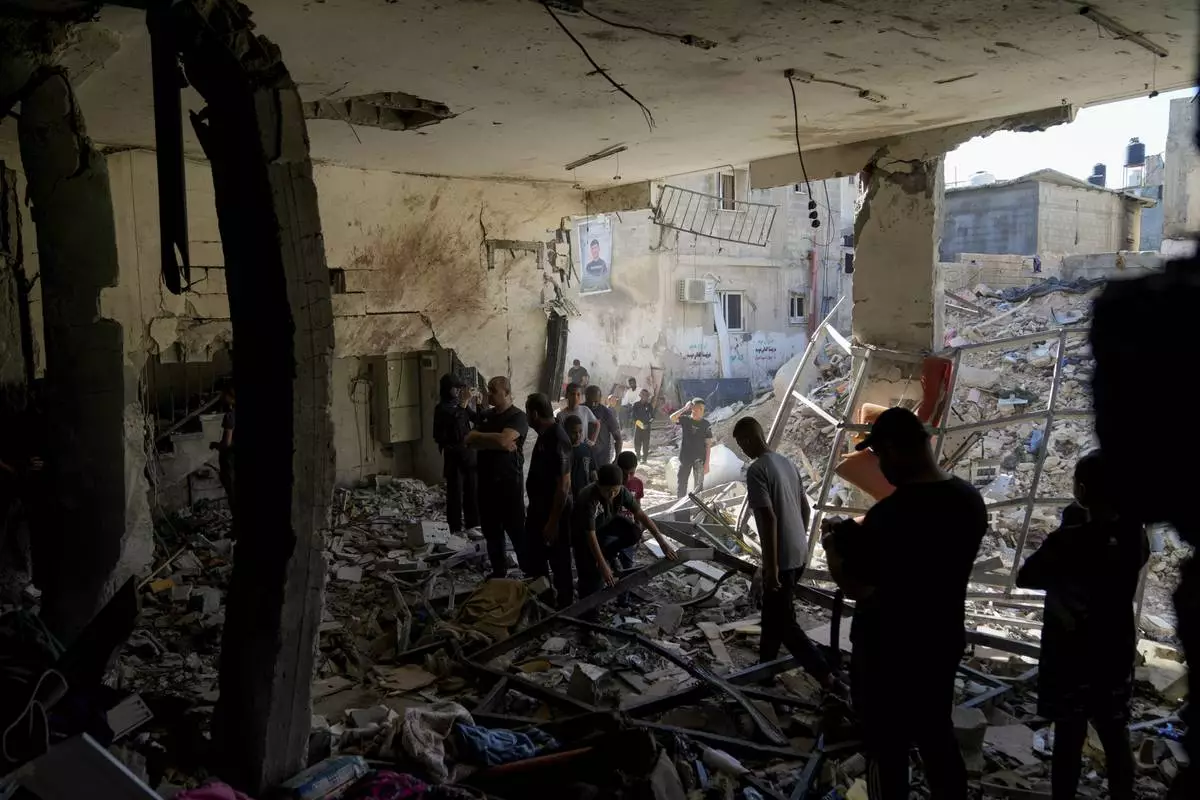
Palestinians examine the damage following an Israeli airstrike in the West Bank city of Tulkarem, which Palestinian health officials say killed 18 people and the Israeli military says took out a Hamas leader, on Friday, Oct. 4, 2024. (AP Photo/Nasser Nasser)
WASHINGTON (AP) — In the aftermath of this week's tariff whiplash, President Donald Trump is deciding exactly what he wants out of trade talks with as many as 75 nations in the coming weeks.
Trump is also figuring out next steps with China. He upped his tariffs on Chinese goods to 145% after China placed retaliatory taxes of 84% on imports from the U.S. While his 90-day pause on other tariffs caused the stock market to rally on Wednesday, countries still face a baseline 10% import tax instead of the higher rates announced on April 2.
Kevin Hassett, director of the White House National Economic Council, told Fox News’ “Fox and Friends" on Wednesday that the administration already has “offers on the table from more than 15 countries.”
Hassett said the next step will be determining exactly what Trump wants out of the negotiations.
“We have a meeting today with all the top principals where we’re going to present to the president a list of what we think his priorities might look like," Hassett said. "And I’m sure he’s going to, you know, have his own ideas about where to move things.”
Here's a look at where Trump's tariffs showdown stands:
With $28.9 trillion in publicly held debt, the U.S. government can still be beholden to the investors who lend it money. Trump might be willing to run roughshod over political rivals, judges he dislikes and a host of political norms, but the bond market showed Wednesday that it can temper his plans.
Going into Wednesday, the interest rate on a 10-year U.S. Treasury note was increasing and approaching 4.5%. That meant the U.S. government was having a tough time finding possible buyers for its debt, as market participants were wondering if Trump's tariffs had caused foreign buyers to sour on the U.S. government. Higher interest rates for the government could trigger even higher mortgage rates and auto loans for consumers, among other problems.
Trump on Wednesday said investors were getting “yippy,” but after his tariff pause he described the bond market as “beautiful.”
The S&P 500 stock index jumped 9.5% after the pause was announced. But reality crept back in on Thursday and the stock market slumped. Sure, Trump was no longer going to put a 20% tariff on goods from the European Union, a 24% tariff on Japan or 25% on South Korea. But those nations still have imports taxed at an elevated 10%, Trump's new baseline as trade talks begin. And tariffs went up against China, locking the world's two largest economies in a trade war.
Plus, the trade war has expanded with China, and 25% tariffs still apply to imported autos, steel and aluminum. Imports from Canada and Mexico, the two largest U.S. trading partners, still face import taxes of as much as 25%. And Trump still plans tariffs on pharmaceutical drugs, lumber, copper and computer chips.
“While we appreciate the pause, the reciprocal tariff of 10% still represents more than double the tariff on imports of leather footwear from countries like Vietnam and Cambodia,” said Tom Florsheim, CEO of the Weyco Group, a footwear company. “Even at this level, it means a significant cost increase that will impact consumers.”
Because tariffs are taxes paid by importers, the costs generally get passed along to consumers and businesses in the form of higher prices and slower economic growth. The Budget Lab at Yale University estimated on Thursday that even with the pause, Trump's current tariff regime would pull down a household's average disposable income by $4,364.
Treasury Secretary Scott Bessent said that any trade agreements will be “bespoke” deals, rather than some overarching pact among a group of countries. Trump has laid out a series of grievances and goals regarding tariffs, but Canadian and European counterparts have said the actual asks from administration officials have been vague so far.
Trump has said he wants to eliminate the $1.2 trillion trade deficit, which means he no longer wants the U.S. to import more goods than it exports to other nations. He also wants revenues from tariffs to offset his income tax cut plans. The president has also said he wants the tariffs to bring back factory jobs and raise workers’ wages.
Aides have said that Trump wants other nations to scrap regulations and other policies such as Europe's value-added taxes that he deems to be a barrier to U.S. goods, an ask that would require other countries to change their laws. Commerce Secretary Howard Lutnick has said the goal is to get other nations to “respect” Trump.
His goals might not necessarily be in line with what other nations want.
European Commission President Ursula von der Leyen posted on X that she's “consistently advocated for a zero-for-zero tariff agreement between the European Union and the United States.”
Lori Wallach, director of the Rethink Trade program at the American Economic Liberties Project, said Trump needs to be more publicly forthright about what he wants out of trade talks and tariffs.
“Absent transparency about what is being demanded, we could end up with the worst of all outcomes — a bunch of bad special interest deals, all of the economic damage caused by tariff uncertainty and no trade rebalancing, US manufacturing capacity or goods jobs,” she said.
The Trump administration views China as violating basic trade norms with how it subsidizes its manufacturers, takes intellectual property from its global competitors, suppresses wages for its workers and manipulates its currency.
The White House clarified that the 125% tariffs that Trump announced on Wednesday against China were actually 145%, once his previous 20% fentanyl tariffs were included.
Census Bureau data show the U.S. ran a $295 billion trade deficit last year with China. Because U.S. consumers and businesses are such a major customer of Chinese manufacturers, Bessent has said that gives the U.S. an edge in terms of inflicting pain on that nation's economy through tariffs. Of course, China has also spent several years preparing for a trade war.
Wendong Zhang, an economist at Cornell University, said that the Chinese economy might suffer a steeper hit to its gross domestic product than the U.S., but it's “likely to stick to its guns” due to internal public support and the ability to increase consumption domestically on goods that might no longer be going to the U.S.
Meanwhile, Trump will need to deal with voters who might be frustrated over the higher price of electronics and other goods resulting from the trade wars.
“Many products that the U.S. imports are predominantly from China: smartphones (73%), laptops (78%), video game consoles (87%), toys (77%), and also antibiotics for U.S. livestock production," Zhang said in an email. “Resourcing from other countries will take time and result in much higher costs.”
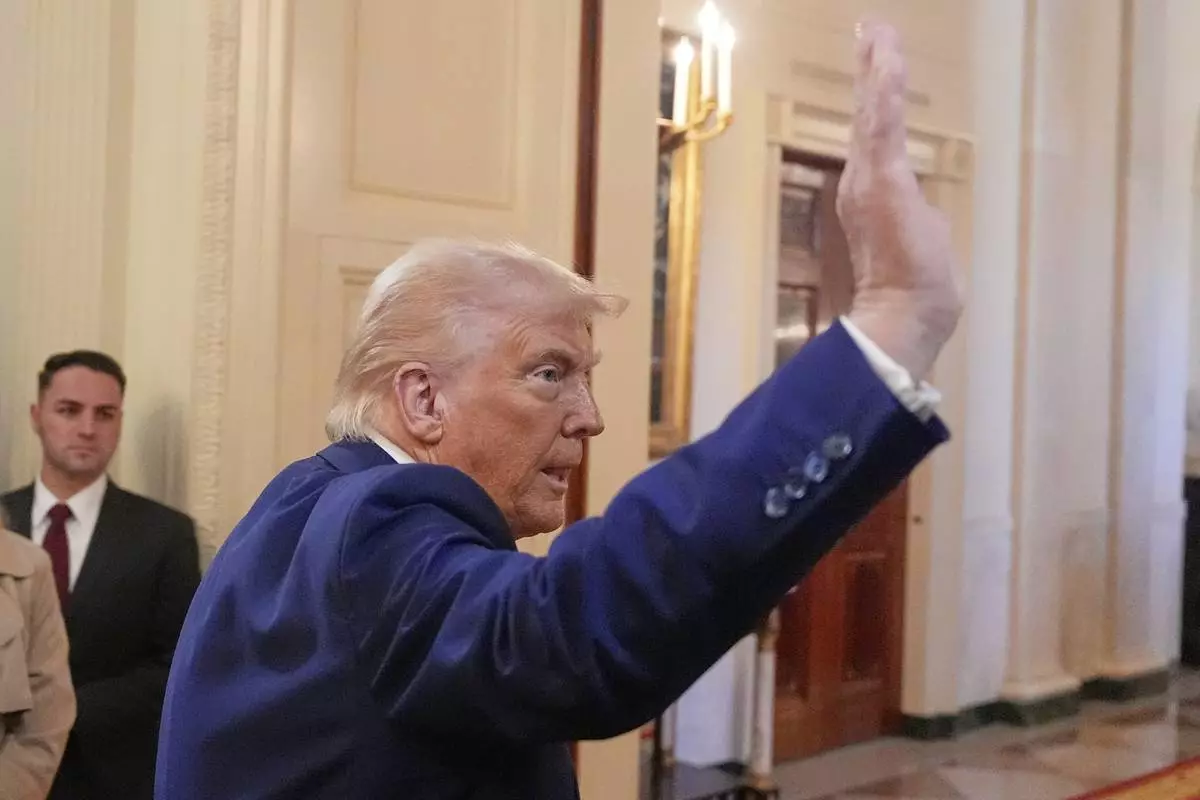
President Donald Trump departs after an event in the East Room of the White House, Tuesday, April 8, 2025, in Washington. (AP Photo/Alex Brandon)








